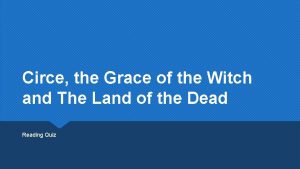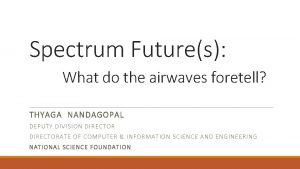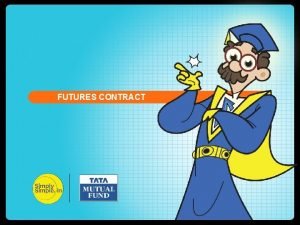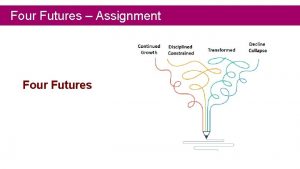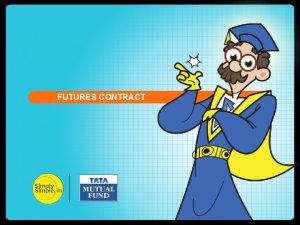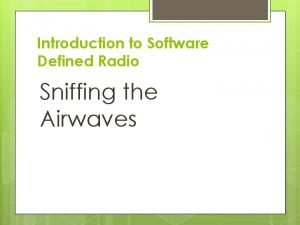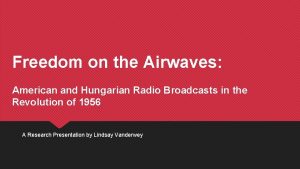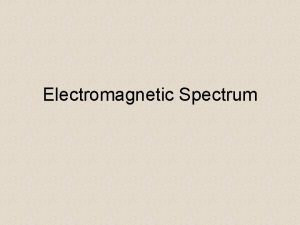Spectrum Futures What do the airwaves foretell THYAGA










- Slides: 10

Spectrum Future(s): What do the airwaves foretell? THYAGA NANDAGOPAL DEPUTY DIVISION DIREC TO R DIRECT ORA TE OF C OMP UT ER & INFO RMATION SCIENCE AND ENGINEERING NATIONAL S CIENCE F OUNDATIO N

Disclaimer Any opinions, findings, and conclusions or recommendations expressed in this material are mine alone. These do not necessarily reflect the views of the National Science Foundation.

Spectrum use: a select (tinted) history 1934 Communications Act of 1934 Federal Communications Commission (FCC) established Post. World War I Selfgoverned public broadcast 1900 s Radio use on ships 1912 Radio Act of 1912 (first regulation of spectrum) 1927 Radio Act of 1927 Federal Radio Commission established Radio Licenses created 2015 Three-tier access system for 3. 5 GHz CBRS band 1994 Spectrum Auctions start 1941 – 1945 Frequency Scarcity Principle Radio frequency relocation (AM Station reassigments, FM limits) 2008 TV White Space Reallocation

Common themes Spectrum is scarce ◦ Yet, more spectrum keeps becoming available over time ( technology enabled ) Moving spectrum users around is hard ◦ Yet, it happens when there is a desire to make it happen ( limited by economic and policy constraints ) Regulators are willing to try new methods of spectrum allocation ◦ Yet, it takes a lot of time to make it happen ◦ No harm principle requires data from studies ◦ No unbiased sources of data that regulators can rely on – creates more uncertainty

Where we are today? Fixed frequency assignments (set largely many years/decades ago) Unlicensed spectrum bands (largely governed by Part 15 FCC rules) Shared use in 3. 5 GHz Wired Communications Analogy: ◦ Dedicated circuits ◦ Ethernet ◦ On-demand shared circuits -circa 1993

Where do we need to be? Imagine data networks of today: Multi-homed end devices Switched Ethernet at the edge Carrier Aggregation for 400 Gbps Ethernet Interconnection agreements with multiple carriers What is the wireless equivalent?

A Spectrum Future… Imagine: A set of unlicensed and unrestricted frequencies (spanning low-, mid - and high-bands) Devices that want to communicate can self-identify the desired swath of frequencies and power levels to get their data transmitted Self-aware networks – ‘learn on the fly’ Highly resilient

A future within realm of possibility DARPA Spectrum Collaboration Competition (SC 2) Challenge ◦ Hinted at this being feasible with overall efficiency gains in many instances Self-awareness is the primary challenge needed for such a future Artificial Intelligence is key for realization What is needed: ◦ Flexible radios, compute in the radio, diverse waveform library ◦ Light-touch regulation, distributed consensus protocols ◦ Situational awareness and continual learning/inference

How to do it? Research, research and more research ◦ National Science Foundation, Do. D, DARPA, and others ◦ Hundreds of millions of $ investments at play now National Science Foundation Programs ◦ Spectrum Innovation Initiative: National Center for Wireless Spectrum Research (SII-Center) ◦ Platforms for Advanced Wireless Research (PAWR) ◦ POWDER (Salt Lake City), COSMOS (New York City), AERPAW (Raleigh), Colosseum (Boston) ◦ National Radio Dynamic Zone ◦ Research programs in wireless

Conclusion Current spectrum allocation model is not working There is a clear need to innovate There are many ‘futures’ possible, but creative thinking is the need of the hour. ◦ Artificial Intelligence and Data-driven learning/inference are helpful Leverage current R&D programs
